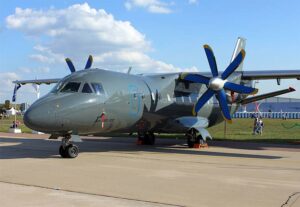 |
| IRAN HESA Simorgh Transport Aircraft |
From December 10 to 13, 2024, Iran hosted its largest-ever aerospace and aviation industry gathering. Simorgh light transport aircraft participated in the event. The Simorgh aircraft is designed and manufactured by the Defense Ministry and homegrown knowledge-based companies, according to Defense Minister Brigadier General Aziz Nasirzadeh, who was speaking to reporters on the sidelines of the event. He observed that the transport plane adheres to international standards and regulations. The purpose of the development of this aircraft, according to authorities, is to improve the nation’s defensive capabilities.
In June 2024, Tehran undertook the first flight testing for the “Simorgh” transport aircraft. The Iran Aircraft Manufacturing Industrial Company (HESA) is the manufacturer of this aircraft. Simorgh is a mythical bird that is depicted in Persian literature and legend.
In announcing the test flight, Iran’s Minister of Defense and Armed Forces Logistics, Mohammad Ashtiani, stated, “The flight tests of this aircraft are being carried out with the assistance of the Civil Aviation Organization (of Iran), and after this stage, the ‘Simorgh’ aircraft will join the country’s fleet.”
A second aircraft of this model is currently being assembled, according to the director of the Ministry of Defense. The Ministry of Defense was assigned the responsibility of developing the “Simorgh” by the late President Ebrahim Raisi. Ashtiani clarified that Tehran collaborates with numerous other nations to ensure the supply of other components, while specific components of the aircraft are manufactured within Iran.
Iran undertook a collaborative initiative with the Ukrainian company Antonov in the 1990s to manufacture passenger aircraft within the country’s frontiers. The Antonov An-140 production line was relocated to Iran and installed at HESA to finalize this project. The aircraft in question is known as the IRAN-140. Numerous units of IRAN-140 were produced by the organization. Nevertheless, technical constraints necessitated the cessation of the production line. The Civil Aviation Organization prohibited the flight of this aircraft in 2014 in response to the Tehran-Tabas flight accident. As a result, the Antonov engineers who were in Iran were required to depart the country.
However, the aircraft’s production line continued to operate within the nation. The IRAN-140 aircraft was redesigned by HESA to expand its spectrum of applications and meet the operational needs of the armed forces. Due to this redesign, the aircraft’s design was required to be revised to enable use for alternative purposes, including transporting cargo. Extensive technical expertise and numerous rigorous tests are required for even the slightest modifications to aircraft in the aviation sector.
The Simorgh aircraft, which is powered by two Klimov TV3-117 turboprop engines, is capable of flying a distance of 3,900 kilometers and achieving a maximum speed of 530 kilometers per hour. To lift off, a runway must be at least 1,450 meters in length, while landing necessitates a runway that is approximately 1,000 meters in length. According to Iranian media, it is a suitable option for both military and commercial transport fleets, as it can transport up to six tons of cargo. The aircraft has a length of 23 meters, a width of 25 meters, and a height of 8 meters.
The Simorgh aircraft is engineered to accommodate a diverse array of cargo, such as light-wheeled vehicles. It can carry 463L standard pallets. It is also capable of conveying injured personnel, as its interior space can accommodate 24 stretchers for this purpose. Paratrooper deployment and operations during emergencies are supplementary capabilities. Additionally, the Simorgh is capable of landing and taking off at facilities that require minimal equipment.
The Simorgh transport aircraft was first unveiled On May 19, 2022. Modifications to the aircraft’s structure, particularly in the empennage (tail section), are evident in a visual comparison of the IRAN-140 and the Simorgh. One of the most significant differences between the Simorgh and the IRAN-140 is the horizontal stabilizer. The Simorgh is distinguished by its flat horizontal stabilizer, which is in stark contrast to the IRAN-140’s V-shaped tail. The horizontal stabilizer structure has been altered to incorporate both fixed and movable surfaces, as well as the addition of a movable cargo door (ramp).
To integrate a movable cargo entrance into the rear fuselage, accurate aerodynamic and structural calculations were necessary. According to the Iranian media, for the first time in the country’s aviation industry, Iranian specialists in the design office and HESA company effectively completed the task without the assistance of foreign countries.
The Simorgh’s wing configuration has been redesigned and reengineered from trapezoidal to rectangular, resulting in a significant increase in wing area in comparison to the IRAN-140.
The expanded wing area offers a variety of advantages, including a longer flight duration, a reduced runway length required for takeoff and landing, and a greater induced drag, which enhances stability and control.
The engine was also refined by Simorgh’s designers. The primary reason for this optimization and specific modifications to Simorgh’s engine in comparison to the IRAN-140 was that the previous engine was inadequate for the climatic conditions of Iran.
Official Website of Youtube Channel – Altitude Addicts

